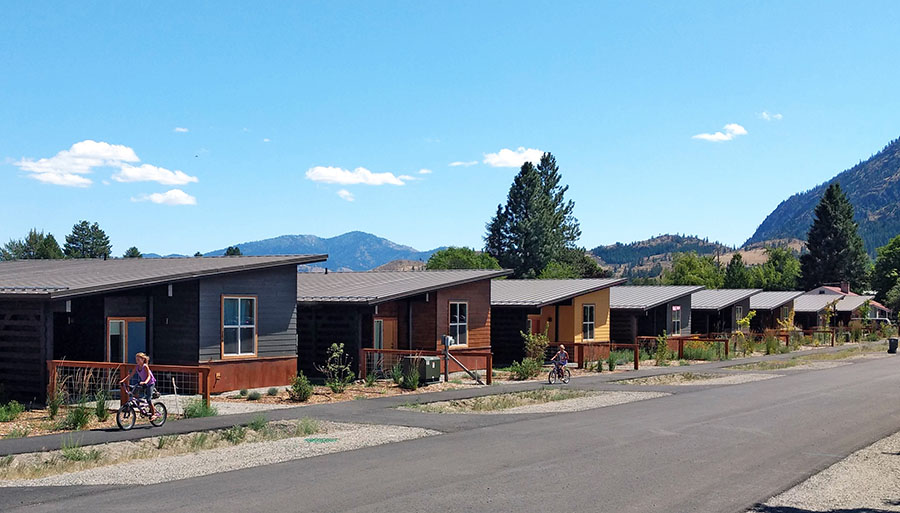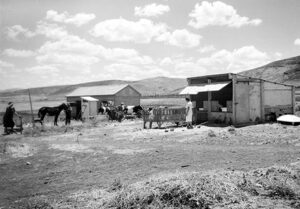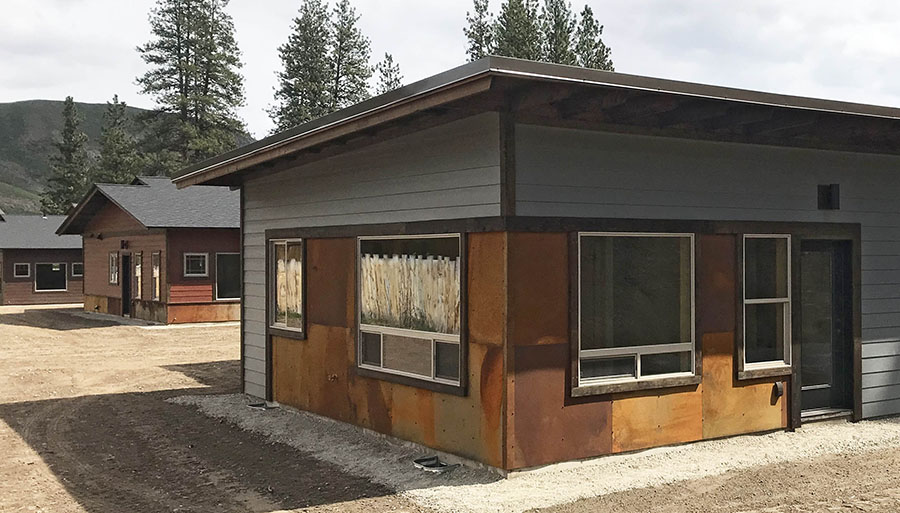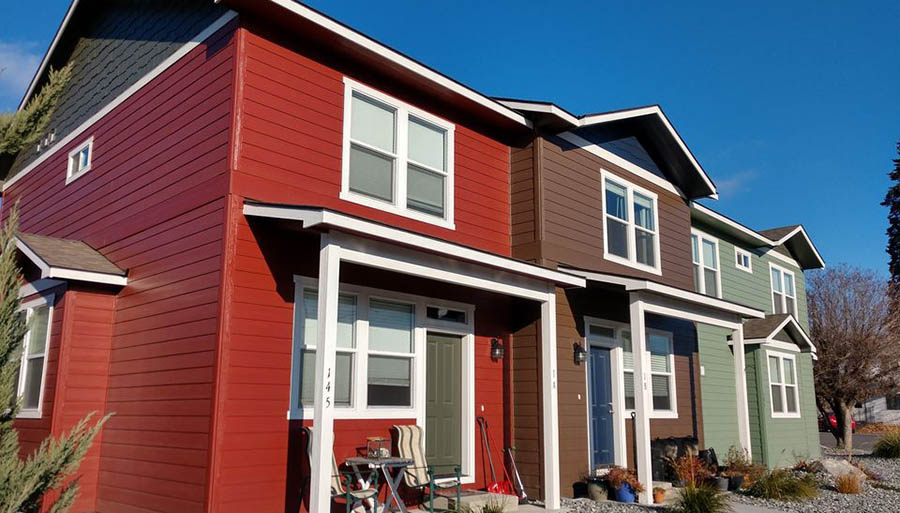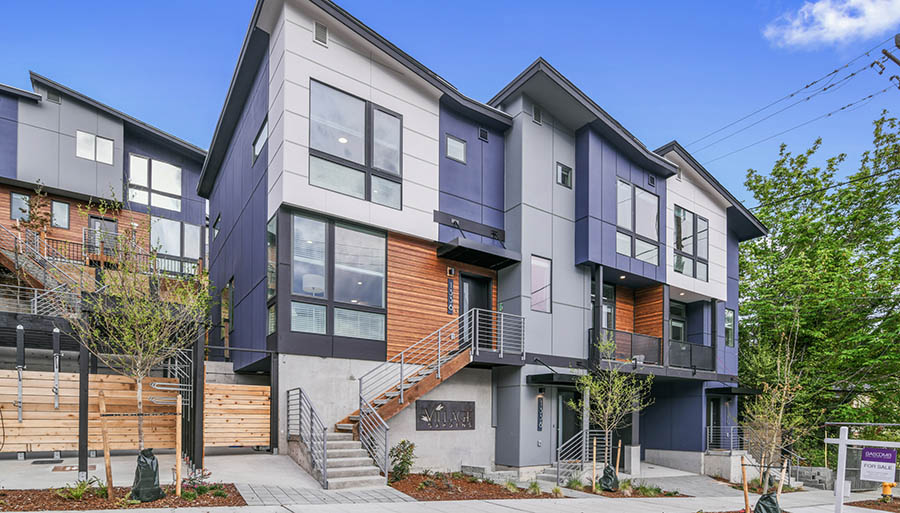Permanent affordability. That’s their beauty. Resale restrictions that control home prices while allowing the seller to reap the benefits of homeownership. That’s their ingenuity. Hear how four Washington community land trusts are garnering community and government support to grow their land trusts and meet the housing needs of their communities. (Pictured above: homes in the Methow Housing Trust.)
Housing Resources Bainbridge (HRB) is one of roughly 250 community land trusts nationwide, about thirty of which are located in the Pacific Northwest. We reached out to a few of our Washington neighbors to see how they are using this model of permanently affordable housing to address the housing crisis in their region.
Land and construction are expensive, so as you’ll see below, these land trusts work hard to get homes built. They must earn the support of their communities and advocate for government funding, policies, and programs that facilitate the creation of affordable housing. However, permanent affordability means that this initial public and private investment and the land itself will serve generations of families to come, making the community land trust one of the most far-reaching and sustainable models of affordable housing.
In a world where the housing market has become untethered from the realities of many families, community land trusts align home prices with wages, creating housing stability and extending the opportunity to safely build wealth to those who have been shut out of the conventional market. We are grateful to work alongside and learn from these inspiring and skillful organizations, which like us, believe in building equitable, inclusive, and strong communities.
How community land trusts work
Community land trusts (CLTs) are nonprofit organizations that conserve land for affordable housing, removing it from the profit-driven real estate market and using it for the long-term benefit of the community. They build or acquire homes and sell them to income-eligible households. But they never give up ownership of the land. Instead, they lease it to the homeowner for a 99-year term with the option to renew. Regulations in the ground lease—not market forces—dictate the sale price, ensuring that these homes remain affordable to future buyers while still allowing the seller to build equity. CLTs can also include rental homes, farmland, and business and community spaces.
CLTs work closely with buyers, shepherding them through the entire home-buying process and applying their expertise in low-interest government loans, down payment assistance, and other programs that help bridge the affordability gap.
A brief history
Community land trusts emerged from a century of social and economic experiments, whose participants viewed land as a shared resource rather than a means of individual profiteering. Beginning in late nineteenth-century America with single-tax colonies, leased-land communities took root around the world: the garden cities of England, in which a municipality owned and leased land to its residents; the Gramdan Movement of India, inspired by Gandhi’s vision of a decentralized society, in which land was gifted to individual villages by wealthy owners and leased to local farmers; and the moshavs of Israel, where agricultural cooperatives operate on land leased from the Jewish National Fund.
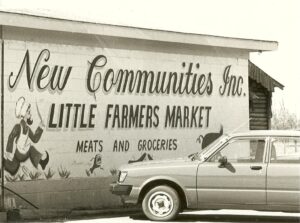 The community land trust we know today, with its democratic ideals and structure, was born in the civil rights movement as a means to secure land for Black sharecroppers who had lost their homes and jobs when they registered to vote. New Communities, Inc. in Lee County, Georgia, was founded in 1969 as an agricultural cooperative and safe haven, and at 5,735 acres it was the largest Black-owned tract of land in the country. In 1981 a severe drought hit the area. An application to the U.S. Department of Agriculture for emergency funds was denied, and in 1985 New Communities foreclosed. A 1999 lawsuit ruled that the denial was discriminatory, and the settlement was used to purchase the 1,638-acre Cypress Pond Plantation property, the present-day incarnation of New Communities.
The community land trust we know today, with its democratic ideals and structure, was born in the civil rights movement as a means to secure land for Black sharecroppers who had lost their homes and jobs when they registered to vote. New Communities, Inc. in Lee County, Georgia, was founded in 1969 as an agricultural cooperative and safe haven, and at 5,735 acres it was the largest Black-owned tract of land in the country. In 1981 a severe drought hit the area. An application to the U.S. Department of Agriculture for emergency funds was denied, and in 1985 New Communities foreclosed. A 1999 lawsuit ruled that the denial was discriminatory, and the settlement was used to purchase the 1,638-acre Cypress Pond Plantation property, the present-day incarnation of New Communities.
Methow Housing Trust
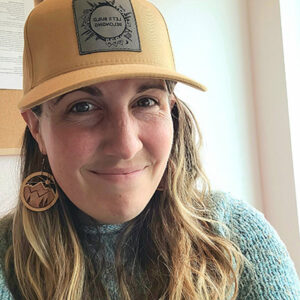 Sarah Thomas, Director of Outreach and Development
Sarah Thomas, Director of Outreach and Development
Homes:
26 single-family homes
49 homes in the pipeline, in multiple neighborhoods, expected completion 2030
What unique aspects of your community land trust have contributed to its success?
Our neighborhoods span our rural valley, from Twisp to Mazama, and our homeowners represent a broad sector of our community, from bakers, servers, small business owners, firefighters, educators, health care workers to volunteers, friends, and families.
A unique aspect of our community land trust is that, in our five years of operating, we’ve used 100% private funding to acquire land and construct homes. Foundational support in the form of partially or fully gifted land, shovel-ready lots, home construction costs, operational pledges, and seed money for an endowment have allowed the Methow Housing Trust to expedite building quality homes for full-time residents who are priced out of the traditional housing market. This has also allowed the Methow Housing Trust to innovate with partners to advance more housing solutions. An example of this is our partnership with the Housing Authority of Okanogan County to develop 22 affordable rental units in our next neighborhood.
Another vital piece to the Methow Housing Trust is our origins as an organization. The Methow Housing Trust was formed to address the need for affordable housing for valley residents, following a six-month housing assessment involving a diverse committee of valley residents, sponsored by the post-fire Methow Valley Long Term Recovery Group. Our community’s commitment to building a more resilient Methow Valley by increasing access to stable, quality housing for all is what allows the Methow Housing Trust to have an impact today, for our valley’s future.
Kulshan Community Land Trust (Whatcom County)
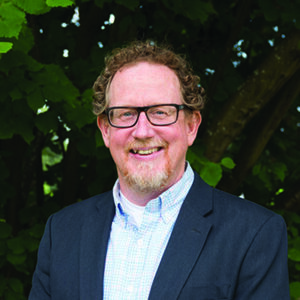 Dean Fearing, Executive Director
Dean Fearing, Executive Director
Homes:
141 homes for ownership; 2 rentals; 1 acre farmland
4 homes under construction
56 homes in the pipeline to be built in the next 1-3 years
50+ homes in the pipeline to be built in 5 years or longer
How have you worked with local government to create policies that support affordable housing?
Kulshan Community Land Trust (KCLT) gets a lot of support from Whatcom County and many of its cities and small towns. The city of Bellingham passed a voter-approved levy which helps fund affordable homeownership projects. Bellingham also created an incentive for affordable housing which gives a 50% density bonus for projects in which 51% of the homes are permanently affordable. Bellingham prioritizes giving surplus property to nonprofit housing developers and gave a single-family lot to Kulshan to develop. We are looking at other land to acquire via the surplus program.
Whatcom County allows the use of Economic Development Investment (EDI) funds, collected via sale tax, for paying permits and fees via a 1% loan amortized over 50 years. And just this year, the county created a loan fund with EDI funds to pay for infrastructure costs. Ten percent of this loan can convert to a grant if 25% of the development is permanently affordable to families at or below 120% area median income (AMI).
The city of Blaine is exploring giving two parcels of land to KCLT for development. This will add 37-47 homes to our pipeline.
KCLT has a robust advocacy committee made up of staff, board, and members of our community. This committee actively engages local elected officials and works to create policy to make affordable housing development easier. The Whatcom Housing Alliance is another resource for advocating for housing policy and raising awareness around affordable housing issues. KCLT was a founding member and actively participates in this organization.
However, even with this government support, KCLT relies heavily on donations. Individual donations and business support make up roughly a third of our budget.
Describe some of the challenges you face in expanding your community land trust and strategies you’ve developed to address them.
As we add land to our pipeline, we are concerned about availability of state funding and other subsidy funding. We are working on a model of mixed incomes with a goal of having higher-priced, higher-AMI homes help cover the cost of lower-priced, lower-AMI homes.
What are your plans for the future? What does success look like?
In 2022 KCLT embarked on a bold plan to grow organizational capacity so that we can develop more homes and serve more families and individuals in our community. We are working with multiple consultants to strengthen integral policies and procedures, assess organizational needs for staffing, and creating a plan and vision to build 25 or more homes each year. A key piece of this strategy is holding land for development, and KCLT has done a great job securing land for our pipeline. KCLT will continue to strive to positively impact the local housing market with a goal of 5% or more of all homes in Whatcom County being permanently affordable to households earning at or below 120% AMI.
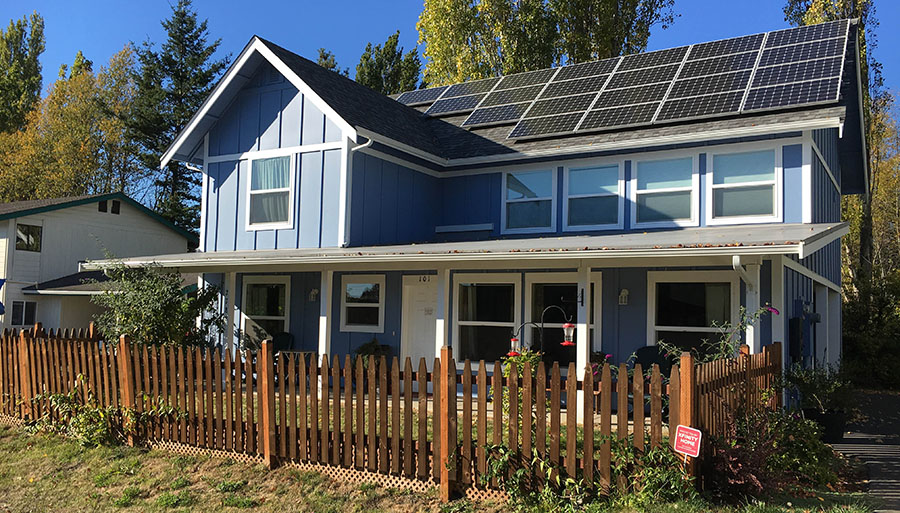
Chelan Valley Housing Trust
 Rachael Goldie, Executive Director
Rachael Goldie, Executive Director
Homes:
5 downtown townhomes for ownership
2 3-bedroom, 2-bath homes for ownership coming in 2023
39 mixed-income, 2-bedroom, 1.5-bath homes for ownership, phase 1 beginning in 2024
How have you worked with local government to create policies that support affordable housing?
We have worked with community planning departments, council, and commissioners to increase use of American Rescue Plan Act (ARPA) funds for housing and to have development agreements and set-asides available for hookup subsidy or construction costs. County and city have contributed $20K per year to our operations. Rep. Mike Steele also has worked to gain us $500,000 by way of a capital budget request for design, planning, and infrastructure on our larger development.
Describe some of the challenges you face in expanding your community land trust and strategies you’ve developed to address them.
The biggest challenges we face are:
- Dwindling interest in discounted or donated land to the trust: We pay full price or more for land within the urban growth area. The county is working on assisting with land acquisition through ARPA and other funding sources.
- Fundraising: In tight times it has been more and more difficult to attract and keep donors that keep our operations live. Our total need is greater than what previous fundraising efforts have proven possible for the valley, therefore the need for exploring resources through city, county, and state is very great.
Homestead Community Land Trust (King County)
 Kathleen Hosfeld, Executive Director
Kathleen Hosfeld, Executive Director
Homes:
245 homes for ownership
150 homes in the pipeline
How have you worked with local government to create policies that support affordable housing?
Homestead Community Land Trust represents all of King County, which means we work with all kinds of cities from the City of Seattle, which I would characterize as a very mature and experienced partner, to smaller cities with very little affordable housing infrastructure. Seattle has funding through its housing levy and staff who administer those levy funds who have experience with community land trusts. Our next most experienced partner is the city of Renton, which has an emerging program. It has zoning and policy infrastructure built out to incentivize affordable housing, but it lacks dedicated funding for homeownership. Further south, there are cities with much less—few if any policies, no funding for affordable housing or homeownership, and no affordable housing plans.
What we try to do is work both directly and in coalition with other affordable homeownership-focused nonprofits, such as the Housing Development Consortium, to meet these cities where they are at and advocate for policies and funding streams that support affordable homeownership at the county and city level. We’re currently working together to advocate to King County Council members for dedicated and ongoing homeownership funding that can support new construction in the King County budget. And I’m working in a coalition with South King County city officials to do the same.
Most of the cities that we engage with want homeownership and are not resistant to allocating resources. However, their hands are often tied. For example, the funding that is available through the sales tax initiative is for people who have incomes below 60% area median income, and it’s very difficult to bring homeownership within reach of these buyers.
What are your plans for the future? What does success look like?
Success looks like funding and supportive policies for permanently affordable homeownership in every metropolitan or city jurisdiction in King County within the next ten years.
